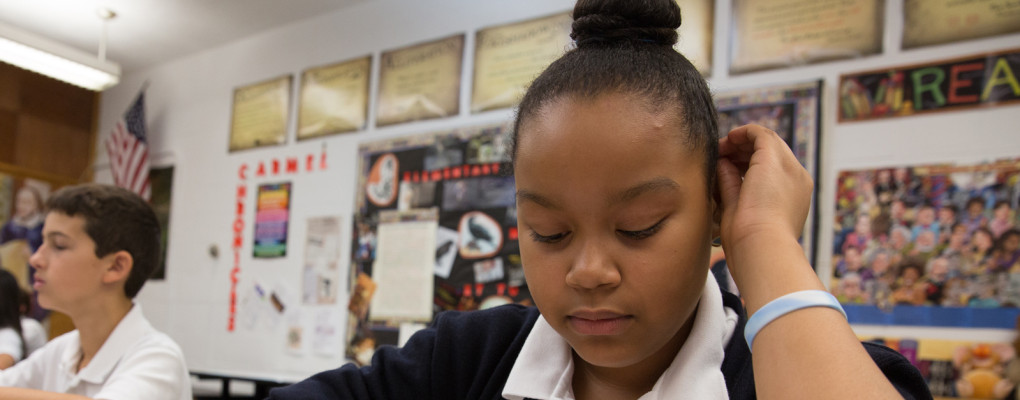The Academy of Our Lady of Mount Carmel is proud to announce that the Middle School now offers an accelerated Reading Program along with our already accelerated Math Program. The new curriculum, at every level and grade, was designed to be diverse, relevant and rigorous.
Now, every student, regardless of their background or reading level, will be reading complex and engaging texts written in a variety of genres, by diverse voices that follow the curriculum maps set by the Archdiocese of Newark. Read the Curriculum Map HERE!
Working with our teachers, consulting public and private curriculum resources and seeing what works in other programs, while logging hours of professional development, we prioritized the basics and focused on critical thinking.
A Three-Fold Approach
Our approach was three-fold: prioritize the basics, to build strong foundational skills. Get students to critically think about relevant, critical problems and grounding our content through the lens of our rich Catholic tradition.
Building Strong Foundational Skills
We are building strong foundational skills that will not only strengthen students’ approach to the basics, but also equip them to become stronger readers and writers. Students will be using a new series of Grammar workbooks, designed to reinforce daily exercises.
Critical Thinking for Critical Problems
In reading, students are guided through a variety of literary genres from diverse voices. We felt that OLMC was doing a good job of teaching students how to read phonetically, but often miss opportunities to ingrain reading into everyday experiences. Our new program seeks to go beyond the traditional “reading log” view of curriculum and make reading a part of various subjects where students will now encounter books in a few unexpected places.
A commitment to literature doesn’t just happen in the four walls of an English classroom. With that in mind we are expanding the notion of where a student might encounter powerful fiction and thought-provoking non-fiction. We now offer, (at all levels) exciting opportunities for cross-curriculum reading as we are incorporating non-fiction and novels into other subject areas.
Grade 6 will be reading and creating in the MakerSpace with Calling All Minds by Temple Grandin. In Grade 7, in Social Studies, students read Fever, 1793 by Laurie Haulse Anderson and in Grade 8 Science, students will be reading Oliver Sacks’s The Man Who Mistook His Wife for a Hat and Other Clinical Tales.
We continue our Drop Everything and Read (DEAR) Program where roughly once a month students read independently making their own reading choices. As always we ask parents to be a part of their independent reading choices.
Lastly, students will be using technology in a variety of classes to reinforce reading comprehension through the use of the new Read to Lead interactive reading gaming platform. The multi-disciplinary game offers a dynamic way for students to move beyond mere reading comprehension and into the areas of critical thinking and assessment, expanding their knowledge and encouraging social and emotional learning.
The Catholic Imagination
Literature is central to the culture of Catholicism, as Saint John Paul II writes:
“The Church needs artists, especially those who can [illuminate the mystery of God] on the literary and figurative level, using the endless possibilities of images and their symbolic force. Christ himself made extensive use of images in his preaching, fully in keeping with his willingness to become, in the Incarnation, the icon of the unseen God.”
Whether Catholic or not, students will use the Catholic lens to think critically about our world, and its problems, making reading relevant to their lives and the realities of our current world. As Saint Cardinal Newman reminds us “If Literature is to be made a study of human nature, you cannot have a sinless Literature of sinful man.”
This Catholic lens sees humanity struggling in a fallen world. Students will encounter characters that have a longing for grace and redemption, they will see that evil exists, though the physical world is not evil but beautiful, and that nature itself is Sacramental and mysteriously charged with God’s love. Finally, students will read stories about how suffering can be perceived as redemptive—the very imitation of Christ’s passion, death and resurrection. This will all be found in texts as diverse as the dark tales of Edgar Allan Poe, the brightly colored illustrations of a graphic novel or the cultural richness from writers like Kwame Alexander, Sherman Alexie and Amy Tan.



